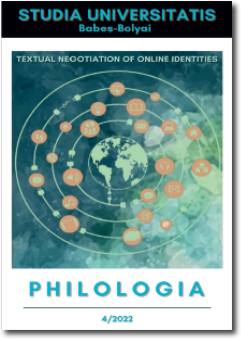UNDERGRADUATE SELF-STUDY: DISCOURSE ANALYSIS OF IMAGESETS ON STUDENT BLOGS
DOI:
https://doi.org/10.24193/subbphilo.2022.4.13Keywords:
blogging, discourse community, images, self-study, writerly selfAbstract
Undergraduate Self-study: Discourse Analysis of Imagesets on Student Blogs. Student writers’ relationship to the screen is initially grounded in their writing experiences in social media, but they come to view their course blog as a connecting space between themselves and their readership, a space which becomes one on which they self-destruct and reconstruct their identity as they learn to write (Serfaty 2004). By asking students to post a digital image of themselves, Ethna Lay initiates an important dataset, one which suggests a great deal about their relationship to writing. Through these images, students construct their independent writerly identities and simultaneously express membership in the class as a discrete discourse community. Students work collaboratively on a discourse analysis of the imageset, categorizing the class’s images as data about its relationship to writing. These imagesets are an opportunity for student writers to stage themselves; they perform how they would like to be seen (or not seen). This performing of the self is at once a private act as well as a communal and public activity (Tifentale and Manovich 2015; Rettberg 2005). The screen then has a dual nature, functioning as either a veil or mirror for student writers (Serfaty 2004). Students classify the imagesets into categories or types, which are fairly consistent across classes. Oftentimes students acknowledge the class had become its own discourse community, its deixis enabled by blogging together and by investigating their blogs, and decide that this result is only possible given the nature of the blog. The students become participant-observers in this respect, and the end result is an auto-ethnography of the pictured self in a social and academic setting.
Article history: Received 8 August 2022; Revised 9 November 2022; Accepted 6 November 2022; Available online 20 December 2022; Available print 30 December 2022.
REZUMAT. Studenții și auto-cunoașterea: O analiză discursivă asupra seturilor de imagini din cuprinsul blogurilor studențești. Relația studenților-scriitori începe cu experiențele lor auctoriale pe rețelele de socializare, ca mai apoi să descopere în blog (ca sarcină de curs) spațiul în care se produce conexiunea dintre ei și cititori, precum și dezasamblarea și reconstruirea identității proprii atunci când învață să scrie texte (Serfaty 2004). Trasându-le sarcina de a posta imagini cu ei înșiși, autoarea inițiază crearea unui set important de informații în virtutea faptului că acesta sugerează multe despre relația studenților cu scrisul. Prin aceste imagini studentul își reconstruiește identitatea de scriitor autonom, care își exprimă, totodată, și calitatea de membru al clasei, aceasta din urmă constituind o comunitate discursivă distinctă. Studenții realizează colaborativ o analiză discursivă asupra setului de imagini, cu imaginile clasei catalogate ca informații despre relația lor cu scrisul. Aceste seturi de imagini le oferă studenților-scriitori oportunitatea de a se pune în scenă; ei se prezintă în rolul în care își doresc a fi văzuți sau dimpotrivă. Acest joc de sine este, simultan, un act privat și o activitate comună publică (Tifentale and Manovich 2015; Rettburg 2005). Ecranul, prin urmare, capătă o natură duală, el funcționând fie ca un văl, fie ca o oglindă pentru studentul-scriitor (Serfaty 2004). Seturile de imagini sunt clasificate drept categorii sau tipuri, care se regăsesc cu relativă constanță în toate cursurile parcurse de studenți. Adesea studenții observă clasa transformându-se ea însăși într-o comunitate discursivă, deictica fiind facilitată de activitatea de blogging colaborativ și de studierea blogurilor colegilor. În final, aceștia ajung la concluzia că rezultatul se datorează tocmai naturii acestui tip de blog. Astfel, studenții devin observatori-participanți iar rezultatul final - o auto-etnografie în imagini în cadrul mediului social și academic.
Cuvinte-cheie: blogging; comunitate discursivă; imagini; auto-cunoaștere; sinele auctorial
References
Bartholomae, David. 2005. “Inventing the University.” In Writing on the Margins: Essay on Composition and Teaching. New York: Palgrave Macmillan.
Bloom, Harold. 1997. The Anxiety of Influence: A Theory of Poetry. 2nd ed. Oxford: Oxford UP.
Brooke, Collin Gifford. 2005. "Weblogs as Deictic Systems: Centripetal, Centrifugal, and Small-World Blogging." Computers and Composition Online (Fall). http://cconlinejournal.org/brooke/brooke.htm.
Downs, Doug, and Elizabeth Wardle. 2007. “Teaching about Writing, Righting Misconceptions: (Re)Envisioning ‘First-Year Composition’ as ‘Introduction to Writing Studies.’” College Composition and Communication 58 (4) (June): 552-584.
Gallagher, John. 2020. Update Culture and the Afterlife of Digital Writing. Louisville, CO: Utah State University Press.
Krause, Steven D. 2004. “When Blogging Goes Bad: A Cautionary Tale About Blogs, Email Lists, Discussion, and Interaction.” Kairos: A Journal of Rhetoric, Technology, and Pedagogy 9 (1) (Fall). https://kairos.technorhetoric.net/9.1/praxis/krause/index.html.
Rettberg, Jill Walker. 2005. "Mirrors and Shadows: The Digital Aestheticisation of Oneself." Proceedings of the Digital Arts and Culture Conference. IT University, Copenhagen. December 1-3, 2005.
---. 2014. Blogging. 2nd ed. Boston: Polity Press.
---. 2014. Seeing Ourselves Through Technology: How We Use Selfies, Blogs and Wearable Devices to See and Shape Ourselves. New York: Palgrave Macmillan.
Serfaty, Viviane. 2004. The Mirror and the Veil: An Overview of American Online Diaries and Blogs. Amsterdam: Rodopi.
Subrahmanyam, Kaveri, and David Smahel. 2011. Digital Youth: The Role of Media in Development. New York: Springer.
Tifentale, Alise, and Lev Manovich. 2015. “Selfiecity: Exploring Photography and Self-Fashioning in Social Media.” In Postdigital Aesthetics: Art, Computation and Design, edited by David M. Berry and Michael Dieter, 109-122. New York: Palgrave Macmillan.
Yancey, Kathleen Blake. 2004. “Made Not Only in Words: Composition in a New Key.” College Composition and Communication 56 (2) (Dec.): 297-328.
Downloads
Published
How to Cite
Issue
Section
License
Copyright (c) 2022 Studia Universitatis Babeș-Bolyai Philologia

This work is licensed under a Creative Commons Attribution-NonCommercial-NoDerivatives 4.0 International License.





 ©Studia Universitatis Babeş-Bolyai Philologia. Published by Babeș-Bolyai University.
©Studia Universitatis Babeş-Bolyai Philologia. Published by Babeș-Bolyai University.